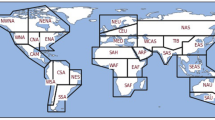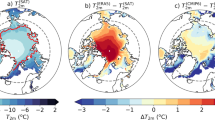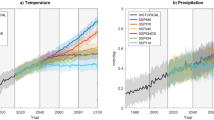Abstract
This paper analyzes surface climate variability in the climate forecast system reanalysis (CFSR) recently completed at the National Centers for Environmental Prediction (NCEP). The CFSR represents a new generation of reanalysis effort with first guess from a coupled atmosphere–ocean–sea ice–land forecast system. This study focuses on the analysis of climate variability for a set of surface variables including precipitation, surface air 2-m temperature (T2m), and surface heat fluxes. None of these quantities are assimilated directly and thus an assessment of their variability provides an independent measure of the accuracy. The CFSR is compared with observational estimates and three previous reanalyses (the NCEP/NCAR reanalysis or R1, the NCEP/DOE reanalysis or R2, and the ERA40 produced by the European Centre for Medium-Range Weather Forecasts). The CFSR has improved time-mean precipitation distribution over various regions compared to the three previous reanalyses, leading to a better representation of freshwater flux (evaporation minus precipitation). For interannual variability, the CFSR shows improved precipitation correlation with observations over the Indian Ocean, Maritime Continent, and western Pacific. The T2m of the CFSR is superior to R1 and R2 with more realistic interannual variability and long-term trend. On the other hand, the CFSR overestimates downward solar radiation flux over the tropical Western Hemisphere warm pool, consistent with a negative cloudiness bias and a positive sea surface temperature bias. Meanwhile, the evaporative latent heat flux in CFSR appears to be larger than other observational estimates over most of the globe. A few deficiencies in the long-term variations are identified in the CFSR. Firstly, dramatic changes are found around 1998–2001 in the global average of a number of variables, possibly related to the changes in the assimilated satellite observations. Secondly, the use of multiple streams for the CFSR induces spurious jumps in soil moisture between adjacent streams. Thirdly, there is an inconsistency in long-term sea ice extent variations over the Arctic regions between the CFSR and other observations with the CFSR showing smaller sea ice extent before 1997 and larger extent starting in 1997. These deficiencies may have impacts on the application of the CFSR for climate diagnoses and predictions. Relationships between surface heat fluxes and SST tendency and between SST and precipitation are analyzed and compared with observational estimates and other reanalyses. Global mean fields of surface heat and water fluxes together with radiation fluxes at the top of the atmosphere are documented and presented over the entire globe, and for the ocean and land separately.

















Similar content being viewed by others
References
Adler RF, Huffman GJ, Chang A, Ferraro R, Xie P, Janowiak J, Rudolf B, Schneider U, Curtis S, Bolvin D, Gruber A, Susskind J, Arkin P (2003) The version 2 global precipitation climatology project (GPCP) monthly precipitation analysis (1979-present). J Hydrometeorol 4:1147–1167
Alexander MA, Blade I, Newman M, Lanzante JR, Lau NC, Scott J (2002) The atmospheric bridge: the influence of ENSO teleconnections on air–sea interaction over the global oceans. J Clim 15:2205–2231
Berry DI, Kent EC (2009) A new air–sea interaction gridded dataset from ICOADS with uncertainty estimates. Bull Am Meteorol Soc 90:645–656
Cai M, Shin C, van den Dool HM, Wang W, Saha S, Kumar A (2009) The role of long-term trend in seasonal predictions: implication of global warming in the NCEP CFS. Weather forecast 24:965–973
Chelliah M, Ebisuzaki W, Weaver S, Kumar A (2010) Evaluating the tropospheric analyses from NCEP’s climate forecast system reanalysis. Clim Dyn (submitted)
Chou SH, Nelkin E, Ardizzone J, Atlas R, Shie CL (2003) Surface turbulent heat and momentum fluxes over global oceans based on the Goddard satellite retrievals, version 2 (GSSTF2). J Clim 16:3256–3273
Cronin MF, Fairall CW, McPhaden MJ (2006) An assessment of buoy-derived and numerical weather prediction surface heat fluxes in the tropical Pacific. J Geophys Res 111:C06038. doi:10.1029/2005JC003324
Dai A (2006) Precipitation characteristics in eighteen coupled climate models. J Clim 19:4605–4630
Dai A, Karl TR, Sun B, Trenberth KE (2006) Recent trends in cloudiness over the United States: a tale of monitoring inadequacies. Bull Am Meteorol Soc 87:597–606
Ebert EE, Janowiak JE, Kidd C (2007) Near real-time satellite precipitation estimates—accuracy and comparison with numerical model outputs. Bull Am Meteorol Soc 88:47–64
Fan Y, van den Dool H (2008) A global monthly land surface air temperature analysis for 1948-present. J Geophys Res 113:D01103. doi:10.1029/2007JD008470
Francis JA, Chan W, Leathers DJ, Miller JR, Veron DE (2009) Winter Northern Hemisphere weather patterns remember summer Arctic sea-ice extent. Geophys Res Lett 36:L07503. doi:10.1029/2009GL037274
Gibson JK, Kallberg P, Uppala S, Nomura A, Hernandez A, Serrano E (1997) ERA description. In: ECMWF ERA-15 Project Report Series, No. 1. European Centre for Medium-Range Weather Forecasts, Shinfield, Reading, UK. http://www.ecmwf.int/publications
Grassl H, Jost V, Schulz J, Ramesh Kumar MR, Bauer P, Schluessel P (2000) The Hamburg ocean–atmosphere parameter and fluxes from satellite data (HOAPS): a climatological Atlas of satellite-derived air–sea interaction parameters over the World Oceans. Report No. 312, ISSN 0937-1060, Max Planck Institute for meteorology, Hamburg, p 130 + figures
Grumbine RW (2009) A posteriori filtering of sea ice concentration analyses. MMAB Tech. Note 282, NCEP, p 7
Grumbine RW (2010a) Operational NCEP sea ice concentration analysis (in preparation)
Grumbine RW (2010b) CFSR sea ice analysis (in preparation)
Higgins RW, Kousky VE, Silva VBS, Becker E, Xie P (2010) Intercomparison of daily precipitation statistics over the United States in observations and in NCEP reanalysis products. J Clim 23:4637–4650
Huang B, Mehta VM, Schneider N (2005) Oceanic response to idealized net atmospheric freshwater in the Pacific at the decadal timescale. J Phys Oceanogr 35:2467–2486
Josey SA, Kent EC, Taylor PK (1998) The Southampton Oceanography Centre (SOC) ocean–atmosphere heat, momentum and freshwater flux Atlas. Southampton Oceanography Centre Rep. 6, p 30 + figures
Josey SA, Kent EC, Taylor PK (1999) New insights into the ocean heat budget closure problem from analysis of the SOC air–sea flux climatology. J Clim 12:2850–2880
Joyce RJ, Janowiak JE, Arkin PA, Xie P (2004) CMORPH: a method that produces global precipitation estimates from passive microwave and infrared data at high spatial and temporal resolution. J Hydrometeorol 5:487–503
Kalnay E et al (1996) The NCEP/NCAR 40-year reanalysis project. Bull Am Meteorol Soc 77:437–471
Kanamitsu M, Ebisuzaki W, Woolen J, Yang SK, Hnilo J, Fiorino M, Potter GL (2002) NCEP–DOE AMIP-II reanalysis (R-2). Bull Am Meteorol Soc 83:1631–1643
Kistler R et al (2001) The NCEP–NCAR 50-year reanalysis: monthly means CD-ROM and documentation. Bull Am Meteorol Soc 82:247–268
Krishna Kumar K, Hoerling M, Rajagopalan B (2005) Advancing dynamical prediction of Indian monsoon rainfall. Geophys Res Lett 32:L08704. doi:10.1029/2004GL021979
Kumar A, Hoerling MP (1998) On the specification of regional SSTs in AGCM simulations. J Geophys Res 103:8901–8907
Long CS, Butler AH, Lin R, Wild J, Yang SK, Zhou S, Liu H (2010) Evaluation of the stratosphere in the NCEP climate forecast system reanalysis. Clim Dyn (submitted)
Mo K, Long LN, Xia Y, Yang SK, Schemm JE, Ek M (2010) Drought indices based on the climate forecast system reanalysis and ensemble NLDAS. J Hydrometeorol (submitted)
Moore GWK, Renfrew IA (2002) An assessment of the surface turbulent heat fluxes from the NCEP–NCAR reanalysis over the western boundary currents. J Clim 15:2020–2037
Onogi K, Tsutsui J, Koide H, Sakamoto M, Kobayashi S, Hatsushika H, Matsumoto T, Yamazaki N, Kamahori H, Takahashi K, Kadokura S, Wada K, Kato K, Oyama R, Ose T, Mannoji N, Taira R (2007) The JRA-25 reanalysis. J Meteorol Soc Japan 85:369–432
Reynolds RW, Smith TM, Liu C, Chelton DB, Casey KS, Schlax MG (2007) Daily high-resolution blended analyses for sea surface temperature. J Clim 20:5473–5496
Roads J (2003) The NCEP–NCAR, NCEP–DOE, and TRMM tropical atmosphere hydrologic cycles. J Hydrometeorol 4:826–840
Saha S et al (2010) The NCEP climate forecast system reanalysis. Bull Am Meteorol Soc 91:1015–1057
Schubert S, Park CK, Wu CY, Higgins W, Kondratyeva Y, Molod A, Takacs L, Seablom M, Rood R (1995) A multi-year assimilation with the GEOS-1 system: overview and results’. NASA Tech. Rep. series on global modeling and data assimilation, No. 6. In: Suarez MJ (ed) NASA, Goddard Flight Center, Greenbelt
Serreze MC, Barrett AP, Stroeve JC, Kindig DN, Holland MM (2009) The emergence of surface-based Arctic amplification. Cryosphere 3:11–19
Shinoda T, Alexander MA, Nehdon HH (2004) Remote response of the Indian Ocean to interannual SST variations in the tropical Pacific. J Clim 17:362–372
Simpson JR, Adler RF, North GR (1988) A proposed tropical rainfall measuring mission (TRMM) satellite. Bull Am Meteorol Soc 69:278–295
Smith SR, Legler DM, Verzone KV (2001) Quantifying uncertainties in NCEP reanalyses using high-quality research vessel observations. J Clim 14:4062–4072
Tomita H, Kubota M, Cronin MF, Iwasaki S, Konda M, Ichikawa H (2010) An assessment of surface heat fluxes from J-OFURO2 at the KEO/JKEO sites. J Geophys Res 115. doi:10.1029/2009JC005545
Trenberth KE, Smith L, Qian T, Dai A, Fasullo J (2007) Estimates of the global water budget and its annual cycle using observational and model data. J Hydrometeorol 8:758–769
Trenberth KE, Fasullo JT, Kiehl J (2009) Earth’s global energy budget. Bull Am Meteorol Soc 90:311–323
Uppala SM et al (2005) The ERA-40 re-analysis. Q J R Meteorol Soc 131:2961–3012
Wang B, Wu R, Li T (2003) Atmosphere–warm ocean interaction and its impacts on Asian–Australian monsoon variation. J Clim 16:1121–1195
Wang W, Chen M, Kumar A (2010) An assessment of the CFS real-time forecast. Weather Forecast 25:950–969
Wu R, Kirtman BP (2005) Roles of Indian and Pacific Ocean air–sea coupling in tropical atmospheric variability. Clim Dyn 25:155–170
Wu R, Kinter JL III, Kirtman BP (2005) Discrepancy of interdecadal changes in the Asian region among the NCEP–NCAR reanalysis, objective analyses, and observations. J Clim 18:3048–3067
Xie P, Arkin PA (1997) Global precipitation: a 17-year monthly analysis based on gauge observations, satellite estimates and numerical model outputs. Bull Am Meteorol Soc 78:2539–2558
Xie P, Chen M, Shi W (2010) CPC unified gauge analysis of global daily precipitation. J Hydrometeorol (to be submitted)
Xue Y, Huang B, Hu ZZ, Kumar A, Wen C, Behringer D (2010) An assessment of oceanic variability in the NCEP climate forecast system reanalysis. Clim Dyn (submitted)
Yu L, Weller RA (2007) Objectively analyzed air–sea heat fluxes for the global ice-free oceans (1981–2005). Bull Am Meteorol Soc 88:527–539
Yu L, Jin X, Weller RA (2006) Role of net surface heat flux in seasonal variations of sea surface temperature in the tropical Atlantic Ocean. J Clim 19:6153–6169
Yu L, Jin X, Weller RA (2007) Annual, seasonal, and interannual variability of air–sea heat fluxes in the Indian Ocean. J Clim 20:3190–3209
Yu L, Jin X, Weller RA (2008) Multidecade global flux datasets from the objectively analyzed air–sea fluxes (OAFlux) project: latent and sensible heat fluxes, ocean evaporation, and related surface meteorological variables. Woods Hole Oceanographic Institution, OAFlux Project Technical Report. OA-2008-01, Woods Hole, p 64
Zhang Y, Rossow W, Lacis A, Oinas V, Mishchenko M (2004) Calculation of radiative flux profiles from the surface to top-of atmosphere based on ISCCP and other global data sets: refinements of the radiative transfer model and input data. J Geophys Res 109. doi:10.1029/2003JD004457
Acknowledgments
We thank Robert Grumbine for his helpful comments on the CFSR sea ice analysis. We greatly appreciate the constructive internal reviews by Amy Butler and Boyin Huang. We thank the anonymous reviewer for the valuable comments and suggestions.
Author information
Authors and Affiliations
Corresponding author
Rights and permissions
About this article
Cite this article
Wang, W., Xie, P., Yoo, SH. et al. An assessment of the surface climate in the NCEP climate forecast system reanalysis. Clim Dyn 37, 1601–1620 (2011). https://doi.org/10.1007/s00382-010-0935-7
Received:
Accepted:
Published:
Issue Date:
DOI: https://doi.org/10.1007/s00382-010-0935-7




